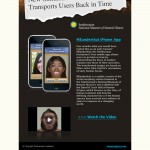Museums today are thinking of themselves far beyond the four walls of their buildings. At the same time, they see their audience as more than those that can afford the plane ticket, hotel room or entrance fee required to see an exhibit in person.
Nancy Proctor, Head of Mobile Strategy and Initiatives at the Smithsonian Institution recently shared her thoughts with me on how the Smithsonian’s MEanderthal App and mobility/portability sit firmly in museum initiatives to provide ways for people to learn from an exhibit whether they visit or not. Here is a condensed and edited version of our conversation:
Q: What is the goal of the MEanderthal App and why did you choose iPhone and Android as platforms?
A: We wanted MEanderthal to be fun, but also educational in some way. It boils down some of the key messages and key learnings from the Human Origins Exhibition and does a good job of putting those in the palm of your hand. We chose iPhone and Android because we wanted to extend reach as far as possible without overreaching on our ability to deliver. Knowing we had only 8 weeks to create the App, our developers felt comfortable focusing on iPhone and Android.
Q: Why are portability and mobility important factors in museum interpretation?
A: There are 3 aspects of mobile that make it a very powerful means of reaching museum audiences. First of all, mobile is exceedingly personal. Jonathan Finkelstein, CEO Learning Times in NY said of podcasts, ‘there’s nothing more intimate than having someone whisper in your ear.’ If you’re listening to audio on a mobile device or reading text in the palm of your hand, it’s the proximity to your body that makes it a very privileged experience. The ergonomics and the operational logistics of the device allow you to say things with an impact that a billboard or a museum wall label will never have.
At the same time, mobile is very social. There’s a mobile version of every major social media platform and there has been from the beginning, it seems. So, putting that personal dimension and the social dimension together makes it very powerful.
The third aspect of mobile that makes it very sympathetic with museums is its ability to convey niche information. Museums are very good at niche stuff. We appeal to people’s special interests through special collections and our staff of specialists that have a very deep level of knowledge of something specific.
People with niche interests or hobbies have very particular exhibition questions they want to ask both of the museum and others interested in the subject. With its mix of being both personal and social, mobile is the ideal interface for that link of experience to audience.
Q: What “first moves” would you recommend to museums or any other organizations that are considering mobile technologies for the first time?
A: The thing that makes me shudder most of all, is that people say ‘Oh we need an App.’ How do you know you need an App? Don’t get an App because it’s shiny and sexy.
Focus on the content and the experience and don’t worry about the technology at all until you have that down. Any kind of information or interpretation system that you’re trying to provide needs to start from the premise that you’re having a conversation with your audiences.
In a museum context, but this probably applies to enterprise as well, I advocate asking, ‘what do people want to know?’ What questions pop into their minds naturally as they walk around the exhibition or collection. If we can start by responding to those questions, then visitors feel personally and individually recognized.
All too often we communicate in a lecture mode – the sage on the stage. If we can turn it around, into a conversation that starts by asking what they’re interested in, it’s more likely to be a successful and sustained conversation. Visitors are more likely to come back to continue the dialogue.
It’s only after you know what the content is, what your audience needs are, and the experience you want to create, that you can even start to decide what is the right platform that supports this content and experience. It might be mobile, but it might not. It may be something that you really need to convey via fixed web. It may be that you can do it with index cards & post-it notes.
Q: What are the most common mistakes institutions make when trying to establish a mobile/portable experience for visitors?
A:
- People get seduced by the technology. They want to create an iPad App because that’s cool.
- They start by asking what do we want to TELL people instead of asking what do people want to know? If we don’t answer visitor questions, we’ve lost them from day one.
- Not thinking of the exchange as a conversation so not caring what the visitor response is once you’ve given them interpretation and information. If it’s a conversation and you’re not listening back, that’s just rude.
Q: What’s your opinion on using location-based technologies in museums and other cultural institutions?
A: I have probably made every mistake in the book when it comes to location-based technologies. So, I’ve learned my lessons the hard way. I think a lot of money has been wasted to come up with a fancy solution for something that can be done for pennies with numbers on a wall label.
Having said that, I think location is extremely important, which is why I keep banging my head against this. I think there are certainly lots and lots of museum situations where at least some sort of optical recognition would help enormously, if not a pure location-based delivery system.
Museum Victoria is exploring one interesting solution. They’ve created a visual panorama of a space to enable a small screen on a pivoting post to recognize what’s in the viewfinder by comparing it to an internally-cached and annotated panoramic photograph of the displays. The screen then gives you information on what you’re looking at like an ‘augmented reality’ overlay. It’s not entirely mobile, but it’s not hard to imagine how this could be done, e.g. with Google Goggles on a mobile device, even indoors where GPS doesn’t work using image recognition instead of geocoordinates to determine where I am.
What I like about this is it’s location-based, but it’s even smarter than location-based. It will tell me I’m in location X but looking at Y. Where a person is looking is what we really want to know.
The thing that gets me most excited about location-based is the ability to take our content to where the people are. It’s always a challenge for museums to reach audiences that can’t visit in person. Location-based technologies can really help us to recreate the sense of excitement and adventure outside of the museum’s four walls, out in the world where the information has context again, and perhaps more meaning.
Imagine you’re walking through Central Park and you receive a bit of information about an object that is part of the Smithsonian knowledge base and it is relevant to your actual location. I’d like to create serendipitous experiences like that. With some really creative content and experienced designers you could do incredible things with location-based systems that would reintroduce the sense of wonder into our everyday worlds.
Q: What predictions would you make regarding the use of mobile devices and/or technologies for museum interpretation?
A: Augmented reality is going to be very important. As Chris McLaren from Tristan Interactive has noted, we’ve had augmented reality for years in the form of audio tours. So we need to build on what we’ve learned from that platform as we go forward into more visual-based augmented reality. Location-based is going to increase in importance.
3D is going to be huge. What we’re seeing with the Internet is the increased importance of the video experience. That’s going to become a 3D video experience. There’s actually a great example of this. If you look at the Metropolitan Museum of Art website for their current exhibition of The Mourners, you’ll find a fantastic 3D experience of the sculptures in that show. You can actually see them better online than you can in person.
Projects like that are changing the way we think an exhibition experience can be.






{ 3 comments… read them below or add one }